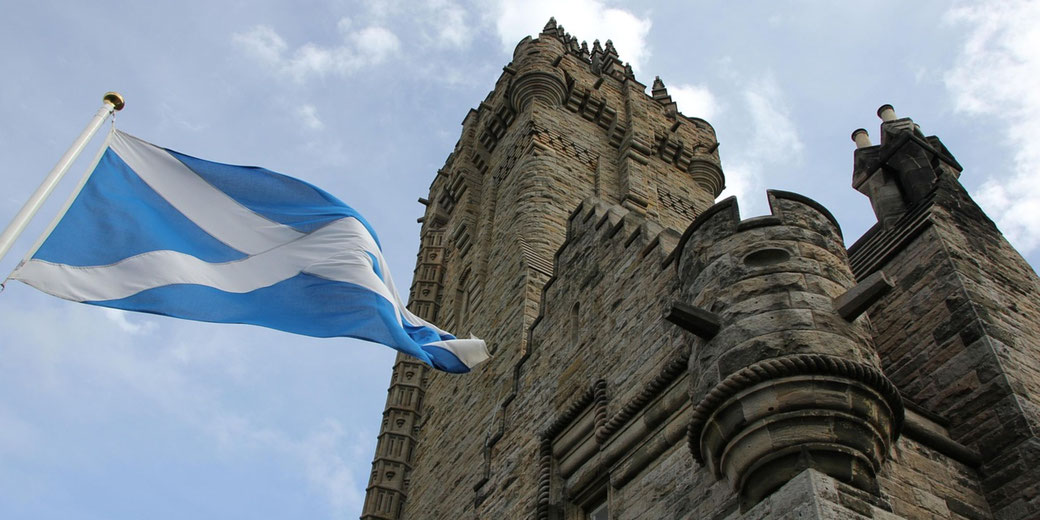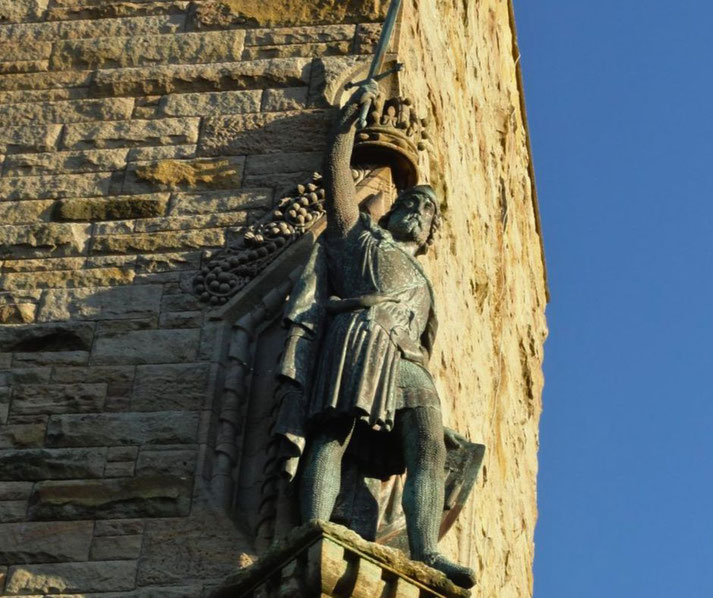The real history of William Wallace, Scotland's medieval freedom fighter

William Wallace was a legendary Scottish warrior who played a pivotal role in the Wars of Scottish Independence in the late 13th and early 14th centuries.
His story, often shrouded in myth and romanticized in popular culture, is a compelling tale of courage, rebellion, and an unyielding pursuit of freedom.
But who was the real William Wallace?
What drove him to stand against the might of the English crown?
And how did his actions shape the course of Scottish history?
Early life and childhood
Born around 1270, Wallace was the second of three sons in a family of minor Scottish nobility.
His father, Sir Malcolm Wallace, owned lands in Elderslie in Renfrewshire and Auchinbothie in Ayrshire, suggesting a comfortable, if not opulent, upbringing.
Despite the lack of specific details about his childhood, it is reasonable to infer that Wallace, like other boys of his status, would have been educated in the basics of reading, writing, Latin, and the principles of land management.
He would also have been trained in the arts of war, learning to handle weapons and ride a horse, skills that would later prove instrumental in his military campaigns.
The political crisis of 13th century Scotland
The late 13th century was a period of profound political upheaval and social change in Scotland.
The death of King Alexander III in 1286, followed by the demise of his granddaughter and heir Margaret, Maid of Norway, in 1290, left the Scottish throne vacant.
This period, known as the 'Great Cause,' saw numerous claimants vying for the throne, leading to a power vacuum and a state of near-anarchy.
The most prominent claimants were John Balliol and Robert Bruce, both of whom had strong but contested claims to the throne.
Unable to resolve the issue internally, the Scottish nobility invited Edward I of England to arbitrate the dispute.
This decision would have far-reaching consequences, as Edward used this opportunity to assert his overlordship over Scotland, a claim that was deeply unpopular among the Scottish people.
Edward's decision in favor of John Balliol in 1292 did little to restore stability.
Instead, it marked the beginning of a turbulent period in Scottish history, characterized by rebellion and war.
Balliol's reign was fraught with tension as he struggled to assert his authority against Edward's overbearing influence.
This tension culminated in the outbreak of the First War of Scottish Independence in 1296, following Edward's invasion of Scotland and deposition of Balliol.
The late 13th century was also a time of economic change in Scotland. The country was gradually transitioning from a subsistence economy based on agriculture and cattle rearing to a more diversified economy with increasing trade and urbanization.
However, the wars and political instability of this period severely disrupted economic development and led to widespread hardship among the Scottish people.
Why did William Wallace rebel?
The exact trigger for Wallace's entry into the struggle for Scottish independence is not definitively known, but it is often attributed to an incident in the town of Lanark in 1297.
According to popular accounts, Wallace's wife, Marion Braidfute, was killed by the English Sheriff of Lanark, William Heselrig.
This personal loss, coupled with the broader political climate of English oppression, is believed to have ignited Wallace's rebellion.
Wallace's first significant act of defiance was the assassination of Sheriff Heselrig in retaliation for his wife's murder.
This act of vengeance marked Wallace as an outlaw but also made him a symbol of resistance against English rule.
His audacity and courage quickly attracted a following, and he began to lead a group of rebels in guerrilla warfare against the English.
The rebellion gained momentum in May 1297 when Wallace and his men burned the town of Lanark and killed its English garrison.
This audacious act of defiance sent shockwaves through the English administration and bolstered the morale of the Scottish resistance.
It also marked Wallace as a significant threat to English rule and a leader in the fight for Scottish independence.
Wallace's rebellion was not an isolated movement. It was part of a broader wave of resistance against English rule that swept across Scotland in the late 13th century.
Other prominent figures, such as Andrew Moray in the north, were also leading rebellions against English rule.
These disparate movements shared a common goal: the restoration of Scottish independence.
The Battle of Stirling Bridge
The Battle of Stirling Bridge, fought on September 11, 1297, marked a turning point in the First War of Scottish Independence and solidified William Wallace's status as a national hero.
This battle was a testament to Wallace's strategic genius and the determination of the Scottish forces to resist English domination.
Stirling Bridge was a crucial crossing point over the River Forth, and controlling it was key to maintaining supply lines and communication.
The English army, led by John de Warenne, Earl of Surrey, and Hugh de Cressingham, underestimated the Scottish forces and made a critical tactical error by attempting to cross the narrow bridge in large numbers.
Wallace and his co-commander, Andrew Moray, capitalized on this mistake. They held their forces back until about half of the English troops had crossed the bridge.
Then, they launched a ferocious attack, trapping the English on the Scottish side of the river while preventing the rest from crossing.
The English forces were thrown into disarray and suffered heavy losses, including the death of Cressingham.
The victory at Stirling Bridge was a significant morale boost for the Scottish resistance.
It demonstrated that the English forces were not invincible and that strategic cunning could overcome numerical superiority.
However, the Battle of Stirling Bridge also came at a great cost. Andrew Moray, Wallace's co-commander and a key figure in the Scottish resistance, was mortally wounded during the battle and died a few months later.
His death was a significant loss for the Scottish cause and left Wallace to carry on the fight for Scottish independence alone.
Appointment as 'Guardian of Scotland'
Following the resounding victory at the Battle of Stirling Bridge, William Wallace's status was elevated from that of an outlaw to a national hero.
His military acumen, leadership skills, and unwavering commitment to the cause of Scottish independence had not only won him the respect of his compatriots but also recognition from the Scottish nobility.
In a significant development, Wallace was appointed as the Guardian of Scotland, a position that effectively made him the leader of the Scottish resistance.
The title of Guardian of Scotland was a prestigious one, typically held by a nobleman of high rank.
It was a testament to Wallace's achievements and his growing influence that he, a man of relatively modest birth, was chosen for this role.
As Guardian, Wallace was tasked with the governance of the kingdom in the name of the deposed King John Balliol and was responsible for leading the ongoing resistance against English rule.
Wallace's tenure as Guardian was marked by a concerted effort to consolidate Scotland's internal affairs and strengthen its international standing.
He embarked on a diplomatic mission to rally support from other European powers, most notably from the Pope, to recognize Scotland's independence.
A letter known as the Lübeck letter, sent in 1297 to the Hanseatic cities of Hamburg and Lübeck, attests to Wallace's efforts to restore trade and diplomatic relations disrupted by the wars.
The Battle of Falkirk
Coming on the heels of his appointment as Guardian of Scotland and the victory at Stirling Bridge, the Battle of Falkirk, fought on July 22, 1298, presented a formidable challenge to Wallace's leadership and military strategy.
The English King Edward I, determined to quell the Scottish rebellion, led an extensive military campaign into Scotland.
The English army, vastly superior in numbers and equipped with formidable longbowmen and heavy cavalry, was a stark contrast to Wallace's forces, which were primarily composed of infantry.
Wallace, aware of the strength of the English army, initially employed a strategy of avoidance, using the Scottish terrain to his advantage and conducting a scorched earth policy to deprive the English forces of supplies.
However, he was eventually forced to confront Edward's army at Falkirk.
The Scottish forces, arranged in four schiltrons (circular, defensive hedgehog formations of pikemen), initially held their ground against the English cavalry.
However, the English longbowmen proved decisive. Their arrows rained down on the Scottish schiltrons, causing significant casualties and breaking their formations.
The English cavalry then charged again, this time breaking through the Scottish lines and causing a rout.

William Wallace's capture and execution
Following the defeat at the Battle of Falkirk and his resignation as Guardian of Scotland, William Wallace's role in the Scottish resistance changed.
He became less of a military leader and more of a diplomat, seeking to garner international support for Scotland's cause.
However, he remained a symbol of defiance against English rule and a target for English forces.
Wallace's capture came about in 1305, a result of betrayal by a Scottish knight, Sir John Menteith.
He was arrested near Glasgow and immediately transported to London, where he was put on trial.
The charges against him were severe: treason against King Edward I (a charge Wallace vehemently denied, stating he had never sworn fealty to Edward), and atrocities against civilians in war, among others.
The trial was largely a formality, with the outcome predetermined. Wallace was found guilty and sentenced to a brutal execution.
On August 23, 1305, he was taken to Smithfield, where he was hanged, drawn, and quartered—a punishment reserved for those guilty of high treason.
His dismembered body was displayed in different parts of England as a grim warning to other potential rebels.
Wallace's execution was intended to quash the Scottish rebellion and demoralize his followers. However, it had the opposite effect.
The brutal manner of his death only served to fuel the Scottish resistance and cement Wallace's status as a martyr for the cause of Scottish independence.

What do you need help with?
Download ready-to-use digital learning resources
Copyright © History Skills 2014-2025.
Contact via email
With the exception of links to external sites, some historical sources and extracts from specific publications, all content on this website is copyrighted by History Skills. This content may not be copied, republished or redistributed without written permission from the website creator. Please use the Contact page to obtain relevant permission.





